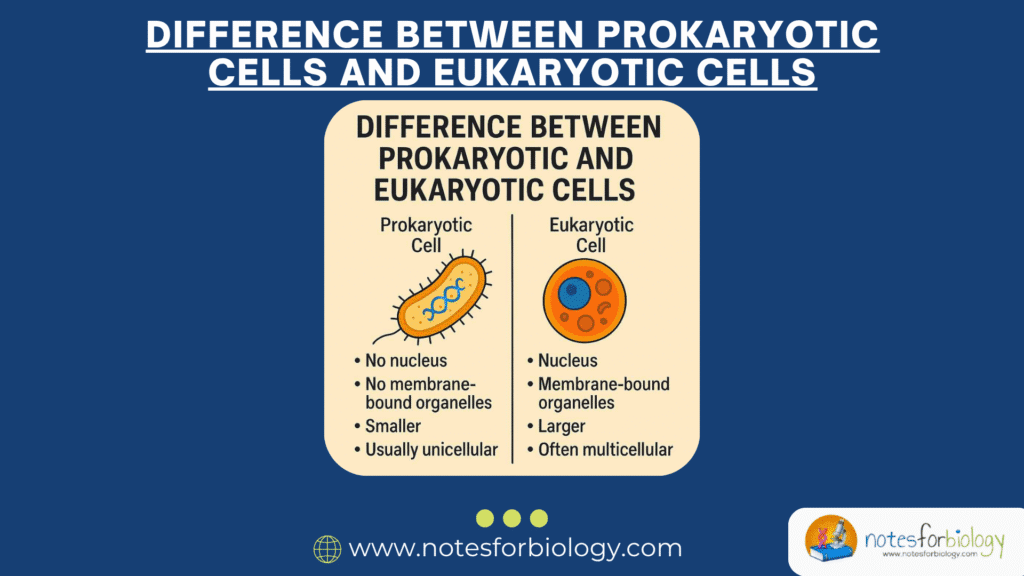Prokaryotic and eukaryotic cells are the two main types of cells that make up all living organisms on Earth. They form the basic unit of life, but they differ significantly in structure, complexity, and function.
What is Prokaryotic cells?

Prokaryotic cells are tiny, simple organisms that lack a nucleus and other membrane-bound organelles. Instead of a nucleus, their DNA floats freely in a tangled clump within the cytoplasm. These cells are usually smaller than eukaryotic cells and have a tough outer cell wall for protection. They reproduce quickly through a process called binary fission. Bacteria and archaea are the two main types of prokaryotes, found almost everywhere from soil and water to inside the human body. Despite their simplicity, they play crucial roles in ecosystems, such as breaking down waste and producing oxygen.
What is Eukaryotic Cells ?
Eukaryotic cells are complex cells that have a well-defined nucleus enclosed in a membrane, along with other specialized structures called organelles (like mitochondria, Golgi apparatus, and chloroplasts in plants). These cells make up animals, plants, fungi, and protists. Unlike prokaryotic cells, eukaryotes are generally larger, more organized, and can form multicellular organisms.
Summary of Prokaryotic Cells
- Prokaryotic cells are primitive, single-celled organisms without a nucleus, packing their DNA freely in the cytoplasm.
- These tiny but mighty cells (like bacteria) thrive everywhere from soil to human guts driving ecosystems and even human health.
- Simple yet powerful, prokaryotes reproduce rapidly via binary fission, making them key players in evolution and biotechnology.
Table of Contents
Difference between Prokaryotic Cells and Eukaryotic Cells

| Feature | Prokaryotic Cells | Eukaryotic Cells |
|---|---|---|
| Cell Type | Simple, primitive cells found only in single-celled organisms (bacteria & archaea). | Complex cells found in animals, plants, fungi, and protists; can be unicellular or multicellular. |
| Nucleus | Lack a true nucleus; DNA floats freely as a nucleoid (no nuclear membrane). | Have a well-defined nucleus enclosed in a nuclear membrane, protecting the genetic material (DNA). |
| Membrane-Bound Organelles | No mitochondria, ER, Golgi, or chloroplasts; only ribosomes (non-membrane-bound). | Contain various membrane-bound organelles (mitochondria, ER, lysosomes, Golgi, etc.) for specialized functions. |
| Size | Much smaller (0.1–5.0 μm). | Generally larger (10–100 μm). |
| Cell Wall | Most have a rigid cell wall (made of peptidoglycan in bacteria). | Only plants (cellulose) and fungi (chitin) have cell walls; animal cells lack them. |
| Reproduction | Asexually reproduce via binary fission (fast, simple division). | Reproduce sexually (meiosis) or asexually (mitosis); more complex process. |
| DNA Structure | Single circular chromosome; may have plasmids (small DNA rings). | Multiple linear chromosomes tightly packed with histone proteins. |
| Ribosomes | Smaller (70S) ribosomes. | Larger (80S) ribosomes; some organelles (mitochondria/chloroplasts) have 70S. |
| Locomotion | Some use flagella (simple, rotary motion) or pili for movement. | Use cilia, flagella (complex, whip-like), or amoeboid movement (e.g., white blood cells). |
| Metabolism | Highly diverse can survive in extreme environments (hot springs, deep oceans). | More restricted; require stable conditions (though some protists/fungi tolerate extremes). |
| Examples | E. coli (bacteria), Methanogens (archaea). | Humans (animals), Mushrooms (fungi), Oak trees (plants), Amoeba (protists). |
Similarities of Prokaryotic Cells and Eukaryotic Cells

- Cell Membrane: Both have a protective outer layer that controls what goes in and out.
- DNA: Both store genetic instructions in DNA.
- Ribosomes: Both make proteins using tiny “factories” called ribosomes.
- Cytoplasm: Both have a jelly-like filling where reactions happen.
- Energy Use: Both use ATP (energy molecules) to power cells.
- Reproduce: Both can grow and make more cells (but in different ways).
- Respond to Environment: Both react to things like food or danger.
- RNA: Both use RNA to help build proteins.
- Unicellular Life: Some eukaryotes (like amoebas) and all prokaryotes are single-celled.
Conclusion
Prokaryotic and eukaryotic cells are the two main types of cells, each with unique features. Prokaryotic cells (like bacteria) are simple, tiny, and lack a nucleus, while eukaryotic cells (found in animals, plants, and fungi) are larger, more complex, and have a nucleus and organelles. Despite their differences, both share basic life processes like DNA, cell membranes, and ribosomes.
In short:
- Prokaryotes = Small & simple (no nucleus).
- Eukaryotes = Big & complex (with nucleus).
- Both = Essential for life!
This shows how life evolves from basic to advanced forms while keeping core functions the same.
Frequently Asked Questions
What is the main difference between prokaryotic and eukaryotic cells?
Prokaryotic cells lack a nucleus and membrane-bound organelles, while eukaryotic cells have both. Prokaryotes are simpler (e.g., bacteria), whereas eukaryotes are complex (e.g., animals, plants)
Do prokaryotes have mitochondria?
No. Prokaryotes generate energy via their cell membrane, while eukaryotes use mitochondria .
Why are eukaryotic cells more complex?
Membrane-bound organelles (e.g., nucleus, Golgi) allow specialized functions, enabling multicellularity.
Related Articles




